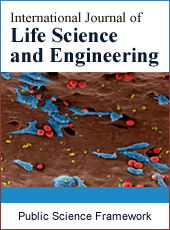International Journal of Life Science and Engineering
Articles Information
International Journal of Life Science and Engineering, Vol.1, No.4, Sep. 2015, Pub. Date: Jul. 9, 2015
Impact of Breeding Hermaphroditic Melon on Early Production and Yield: Case of Snake Melon (Cucumismelo var. flexuosus) and Tibish (C. melo var. tibish)
Pages: 171-176 Views: 5499 Downloads: 1662
[01]
M. E. Abdelmohsin, Department of Crops Sciences, Faculty of Natural Resources and Environmental Studies, University of Kordofan, Elobeid, Sudan.
[02]
A. E. El Jack, Faculty of Agricultural Sciences, University of Gezira, Wad Medani, Sudan.
[03]
M. T. Yousif, Faculty of Agricultural Sciences, University of Gezira, Wad Medani, Sudan.
[04]
A. M. El Naim, Department of Crops Sciences, Faculty of Natural Resources and Environmental Studies, University of Kordofan, Elobeid, Sudan.
[05]
E. A. Ahmed, Faculty of Agricultural Sciences, University of Gezira, Wad Medani, Sudan.
[06]
M. Pitrat, Genetics and Breeding of Fruits and Vegetables, Montfavetcedex, France.
Melon sex types are monoecious, andromonoecious, gynoecios or hermaphrodite. Monoecious is dominant (AG) and hermaphrodite is double recessive (ag). Hermaphrodite ‘Paul’ accession from India crossed with snake melon (monoecious) and tibish (andromonoecious) to transfer hermaphroditic character into both types of melon. F1 progenies of monoecious with hermaphrodite were monoecious, in F2 segregation ratio of 9 monoecious: 3 and romonoecious: 3 gynoecious: 1 hermaphrodite was obtained. But in cross of and romonoecious with hermaphrodite and romonoecy was dominant in F1 and ratio of 3 and romonoecious: 1hermaphrodite were obtained indicated that hermaphrodite is recessive to andromoney. Production of hermaphrodite melon is possible through successive selfing progenies of the crosses. Hermaphrodite lines obtained from these crosses exceeded their parents in earliness and number of fruits/plant
Hermaphrodite, Monoecious, Melon, Sex Expression, Melon Production
[01]
Kirkbride, J. H. 1993. Biosystematics monograph of the genus Cucumis (Cucurbitaceae). Parkway Publishers, Boone, North Carolina, USA.
[02]
Rosa, J. T. 1928. The inheritance of flower types in Cucumisand Citrullus. Hilgardia 3: 233-250.
[03]
Poole C. F. and Grimball, P. C. 1939. Inheritance of new sex forms in Cucumismelo L. J Hered 30:21.
[04]
Abdelmohsin, M.E., ElJack, A.E., Yousif, M.T., Ahmed, E.A., andPitrat, M. 2012. Inheritance of andromonoecy in Tibish.Proceedings of the Xth EUCARPIA meeting on genetics and breedingCucurbitaceae (eds. Sari, Solmaz and Aras) Antalya (Turkey), October, 15-18th, 2012.
[05]
Rudich J, Halev, y A.H. and Kedar, N. 1969. Increase in femaleness of three cucurbits by treatment with Ethrel, an ethylene releasing compound. Planta, 86:69–76
[06]
Stankovic L, Prodanovic S: Silver nitrate effects on sex expression in cucumber. ActaHorticult 2002, 579:203-206.
[07]
Rowe, F.W.E. (1969). A review of the familieHolothuriidae (Holothuroidea: Aspidochirotida). Bulletin of the British Museum of Natural History (Zoology), 18(4): 119-170.
[08]
Poole C. F. and Grimball, P. C. 1939. Inheritance of new sex forms in Cucumismelo L. J Hered 30:21
[09]
Kenigsbuch, D. and Cohen, Y. 1987. Downy mildew- powdery mildew and fusarium wilt resistant in muskmelon breeding line PI 124111F. phytoparasitica, 15: 187- 195.
[10]
Kenigsbuch, D. and Cohen, Y. 1990. The inheritance of gynoecy in muskmelon. Genome 33:317–320.
[11]
Risser, G. and Rode, J. C. 1979. Iduction par le nitrate d’argent de fleursstaminees chez des plantesgynoïques de melon (Cucumismelo L.) Annules de l’Amelioration de plantes 29 : 349) 352
[12]
Kouonon, L. C., Jacquemart, A. Bi, A. I. Z. Bertin, P. Baudoin, J. and Dje, Y. 2009. Reproductive biology of the and romonoecious Cucumismelo subsp. Agrestis (Cucurbitaceae). Annuls of Botany at www.aob.oxfordjournals.org.
[13]
Pitrat, M., Chauvet, M. and Foury, C. 1999. Diversity, history, and production of cultivated cucurbits. ActaHorticulturae 492: 21–28
[14]
Mohamed, EI, and Pitrat, M. 1999. Tibish, a melon type from Sudan. Cucurbit Genetics Cooperative Report, 22:21–23.
[15]
Mohamed, E. I. and Yousif, M. T. 2004. Indigenous melons (Cucumismelo L.) in Sudan: A review of their genetic resources and prospects for use as sources of disease and insect resistance. Plant genetic Resources Newsletter 138: 36- 42.
[16]
Kubicki, B. 1969. Comparative studies on sex determination in cucumber(Cucumissativus L.) and muskmelon (Cucumismelo L.). Genet Pol, 10:167–183.
[17]
Steele, R. G. and Torrie, J. H. 1980. Principles and procedures of statistics: Abiometrical approach. (2nded).McGraw-Hill, N Y. pp633.
[18]
Stepansky, A., Kovalski, I. and Perl-Treves, R. 1999. Intraspecific classification of melons (Cucumismelo L.) in view of their phenotypic and molecular variation. Plant Systematics & Evolution, 217: 313-333
[19]
Esquinas-Alcazar JT, Gulick, P. J. 1983. Genetic resources of Cucurbitaceae. A global report. IBPGR, Rome , Italy
[20]
Munger, H.M. and Robinson, R.W. 1991. Nomenclature of Cucumismelo L. Cucurbit Genetics Cooperative Report, 14:43 –44
[21]
Pitrat, M., Hanelt, P., Hammer, K. 2000. Some comments on interspecificclassification of cultivars of melon. ActaHorticulturae, 510:29–36.
[22]
Taha, M., Omara, K. and ElJack, A. 2003. Correlation among growth, yield and quality charactersin Cucumismelo L. CGC Rept. 26:9-11.

ISSN Print: 2381-697X
ISSN Online: 2381-6988
Current Issue:
Vol. 3, Issue 4, December Submit a Manuscript Join Editorial Board Join Reviewer Team
ISSN Online: 2381-6988
Current Issue:
Vol. 3, Issue 4, December Submit a Manuscript Join Editorial Board Join Reviewer Team
| About This Journal |
| All Issues |
| Open Access |
| Indexing |
| Payment Information |
| Author Guidelines |
| Review Process |
| Publication Ethics |
| Editorial Board |
| Peer Reviewers |


